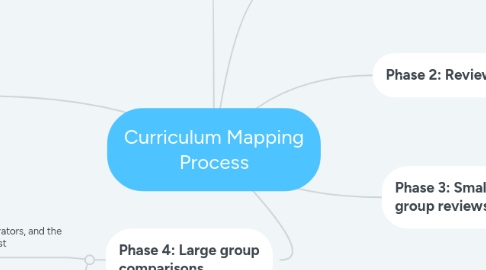
1. Phase 4: Large group comparisons
1.1. Teachers, administrators, and the curriculum specialist
1.1.1. "All faculty members gather to examine the findings of the smaller groups" (Curriculum Mapping, 2016).
1.2. Phase 5: Identify Revision Points
1.2.1. Teachers, administrators, and the curriculum specialist
1.2.1.1. "Identification of immediate revision points and creation of a timetable for resolution" (Curriculum Mapping, 2016).
2. Phase 6: Identify Additional Research and Planning
2.1. Teachers, administrators, and the curriculum specialist
2.1.1. "Identification of points requiring additional research and planning, and a timetable for resolution of those points" (Curriculum Mapping, 2016).
3. Phase 7: Review the Cycle
3.1. Teachers, administrators, and the curriculum specialist
3.1.1. In this phase, "planning for the next review cycle should happen" (Curriculum Mapping, 2016).
4. Phase 1: Data Collection
4.1. Teachers
4.1.1. "Collect data on student performance in relation to each learning objective. Collect data to show student performance for each learning objective. Collect data on student's capabilities" (Taylor, Herbert, Fallshaw, & French, 2013).
5. Phase 2: Review of maps
5.1. Teachers
5.1.1. This phase allows for "a review of all maps by all teachers" (Curriculum Mapping, 2016).
6. Phase 3: Small, mixed group reviews
6.1. Teachers, administrators, and the curriculum specialist
6.1.1. "Groups of five to eight diverse faculty members share individual findings from Phase 2, a review of maps" (Curriculum Mapping, 2016).
